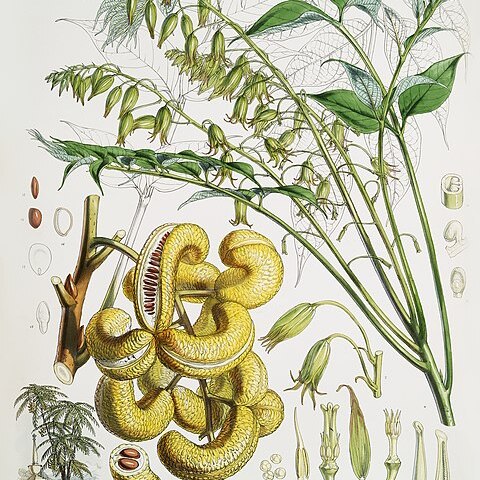Shrubs ca. 5 m tall. Branches robust and brittle, yellow when old; pith broad; lenticels orbicular to elliptic. Winter buds ovoid, apex acuminate, outer scales verrucose. Petiole 10--20 cm; leaf blade pinnately compound, 30--80 cm; leaflets 13--25, ovate to ovate-oblong, 6--14 × 3--7 cm, membranous, abaxially glaucous and pulverulent-puberulous but soon glabrescent, adaxially glabrous, base rounded to broadly cuneate, apex acuminate to caudate-acuminate. Racemes 25--30(--40) cm. Pedicel 0.5--2 cm; bracteoles narrowly linear, 6--8 mm. Sepals ovate-lanceolate to narrowly lanceolate, striate, adpressed crisp, dusty puberulous or glabrous, apex long acuminate. Male flowers: outer 3 sepals 1.7--2(--3) cm; inner 3 sepals slightly shorter. Stamens 8--10 mm; filaments 3--4.5 mm, connate into a slender tube; anthers free, ca. 3.5 mm; connective apical appendage broad, flattened, hornlike, 2--2.5 mm. Pistillodes 1/2 as or rarely as long as filament tube. Female flowers: staminode filaments ca. 1.5 mm, connate into a ring; anthers free, 1.8--2 mm; connective apical appendage hornlike, 1--1.8 mm. Carpels conical, 5--7 mm. Stigma horseshoe-shaped, oblique. Fruit bluish black, pendulous, cylindric, 5--10 cm, ca. 2 cm in diam., verruculose, apex truncate but abaxial suture protruded into a conical umbo; surface with or without annular, depressed, and transverse traces. Seeds black to brown, obovoid to oblong, ca. 1 cm. Fl. Apr--Jun, fr. Jul--Aug.
More
An erect shrub. It can be 4-5 m high. The branches are robust and break easily. The leaf stalk is 10-20 cm long. The leaf blade is compound with leaflets along the stalk. The leaves are 30-80 cm long with 13-25 leaflets. These are oval and 6-14 cm long by 3-7 cm wide. The flowers are separately male and female. The fruit ripen to bluish-black and hang down. They are 5-10 cm long by 2 cm wide. The seeds are brown or black. They are about 1 cm long.
It is a temperate plant. It grows in China in mixed forests on mountain slopes and wet areas between 900-3,600 m altitude. It needs a protected sunny position. It is resistant to frost but sensitive to drought. In Sichuan and Yunnan.
More
Cloud forests and humid, montane forests, woods and thickets; at elevations from 2,000-3,000 metres.

